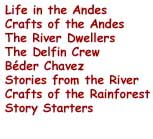

|
Monday, November 13, 2000 Heading Out! This morning was an early wake-up. We wanted to check the website to make sure yesterday's highlights were posted. This morning was the only time during the next two weeks that we could actually see our site until the end of the trip. Thanks to Ernest, our friend receiving our transmissions in the evenings and posting them to the website, they were up!
The Iquitos to Nauta Express
Nauta is a river town located on the Río Marañón just above the confluence with the Río Ucayali. Nauta was settled around the same time as Iquitos. Because of its location farther up the river, it never had the importance that Iquitos had during the rubber boom. Still a frontier town, Nauta is a staging area for much of the exploration that continues in the area. We all wonder what the impact of this new road will be on the surrounding forest. No doubt Iquitos and Nauta will expand towards one another as the population in the area continues to grow.
Slash and Burn Cultivation Once the fields have been abandoned the land becomes eroded, as there aren't any plants to keep the soil in place. Native plants can't grow because there is no topsoil to hold or nourish the seeds. This slash and burn method of cultivation is ultimately very disruptive to the rainforest worldwide. Along the way, we passed a group of people wanting a ride. The driver passed them by. He was worried that they could be dangerous, just as picking up hitchhikers in most countries is considered dangerous. This is also a concern on the river. If a boat flags us for help, the boat captain will have to determine whether it is a true call for assistance or perhaps a decoy to attempt to rob us. Tamara always defers to his judgement when on the river.
The Reserve At Last Just outside of Nauta we entered the Pacaya-Samiria Reserve. This afternoon we traveled up the Río Marañón to the Río Samiria, a much smaller river in the Reserve. Once on the Río Samiria, we will travel all the way up to Ranger Station 5. San Martín village, located at the confluence of Río Samiria and Río Marañón, is the last village in the reserve and will be our last contact with people other than the rangers living at each of the five stations. The long months of planning and preparation have all been worth it. It is absolutely wonderful to be on the river again. And, as Tamara promised, we saw our first dolphins at 3:08 PM. Tomorrow we will start counting them! You may want to review the information about the dolphins and Tamara's research in the River Dolphin section before we start posting our data on Wednesday. A special hello to the students of Mira Flores School in Lima, Peru and Universidad Mayor de San Andres in La Paz, Bolivia. |




